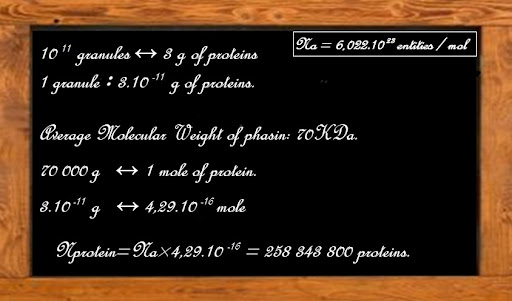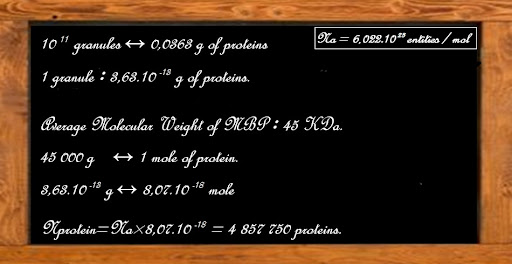Team:INSA-Lyon/Project/Modeling
From 2010.igem.org
| Line 33: | Line 33: | ||
<div id="corps2"> | <div id="corps2"> | ||
| - | |||
| - | |||
<br> | <br> | ||
| + | <h2>Modelling</h2> | ||
| + | <br><br> | ||
<p>We are realizing this modelling to predict how many proteins of interest can be add on each granule. This protein will be associated with the phasins, by a fusion construction. <br /></p> | <p>We are realizing this modelling to predict how many proteins of interest can be add on each granule. This protein will be associated with the phasins, by a fusion construction. <br /></p> | ||
| - | <br | + | <br><br> |
| - | < | + | <h3><font color="purple">Estimation of the number of proteins present on the surface of granules.</font></h3> |
| + | <br><br> | ||
<p> | <p> | ||
Thomas Bäckström, Jane A Brockelbank and Bernd HA Rehm, (New Zealand), had published some interesting data about phasins and granules. <em>(“Recombinant Escherichia coli produces tailor-made biopolyester granules for applications in fluorescence activated cell sorting: functional display of the mouse interleukin-2 and myelin oligodendrocyte glycoprotein”). </em><br /> | Thomas Bäckström, Jane A Brockelbank and Bernd HA Rehm, (New Zealand), had published some interesting data about phasins and granules. <em>(“Recombinant Escherichia coli produces tailor-made biopolyester granules for applications in fluorescence activated cell sorting: functional display of the mouse interleukin-2 and myelin oligodendrocyte glycoprotein”). </em><br /> | ||
| Line 62: | Line 63: | ||
It seems that each granule presents about 2,6 10<exp>8</exp> proteins on its surface, corresponding to 330 proteins by nm². | It seems that each granule presents about 2,6 10<exp>8</exp> proteins on its surface, corresponding to 330 proteins by nm². | ||
</p> | </p> | ||
| - | <br | + | <br><br> |
| - | + | ||
| - | <br | + | |
| - | < | + | <h3><font color="purple">Fusion phasin/ intein/ interest protein</font></h3> |
| + | <br><br> | ||
<p> | <p> | ||
We designed a fusion sequence that associates a phasin, an intein and a GFP. The challenge is to know the percentage of functional hybrid proteins that would be translated in our system. Indeed, our modified phasins will be in competition with the constitutive phasins, which coding sequence is present on the bacterial chromosome. In order to displace the balance, we plan to over-express the modified phasins and to associate various phasins together, to increase its affinity for the granule, as indicated in <em>Banki and Al, 2005 </em>.<br /> | We designed a fusion sequence that associates a phasin, an intein and a GFP. The challenge is to know the percentage of functional hybrid proteins that would be translated in our system. Indeed, our modified phasins will be in competition with the constitutive phasins, which coding sequence is present on the bacterial chromosome. In order to displace the balance, we plan to over-express the modified phasins and to associate various phasins together, to increase its affinity for the granule, as indicated in <em>Banki and Al, 2005 </em>.<br /> | ||
Revision as of 14:15, 27 October 2010
Modelling
We are realizing this modelling to predict how many proteins of interest can be add on each granule. This protein will be associated with the phasins, by a fusion construction.
Estimation of the number of proteins present on the surface of granules.
Thomas Bäckström, Jane A Brockelbank and Bernd HA Rehm, (New Zealand), had published some interesting data about phasins and granules. (“Recombinant Escherichia coli produces tailor-made biopolyester granules for applications in fluorescence activated cell sorting: functional display of the mouse interleukin-2 and myelin oligodendrocyte glycoprotein”).
In their experiments , they manage to extract 3g of proteins from a liquid culture containing 10
The phasins are the most numerous proteins of the granules. We can make the hypothesis that these 3g of proteins correspond to 3g of phasins. The average molecular weight of the phasins is about 70 kDa. By this way, we can now estimate the quantity of proteins in mole and then the number of proteins present in each granule, using Avogadro constant.

It seems that each granule presents about 2,6 10
Fusion phasin/ intein/ interest protein
We designed a fusion sequence that associates a phasin, an intein and a GFP. The challenge is to know the percentage of functional hybrid proteins that would be translated in our system. Indeed, our modified phasins will be in competition with the constitutive phasins, which coding sequence is present on the bacterial chromosome. In order to displace the balance, we plan to over-express the modified phasins and to associate various phasins together, to increase its affinity for the granule, as indicated in Banki and Al, 2005 .
Basing on the experiments realized by this team about the purification of a Maltose Binding Protein (MBP), we can try to predict the percentage of modified phasins present in the surface of the granules.
In a liter of culture (10
The molecular weight of the MBP is about 45 kDa. By this way, we can estimate the quantity of MBP in mole, and then the number of phasins modified with MBP present in each granule, using the Avogadro constant .

It seems that each granule presents about 4,9 10
By this estimation, the ratio
 "
"


